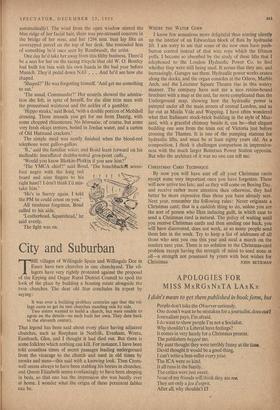City and Suburban
THE villages of Willingale Spain and Willingale Doe in Essex have two churches in one churchyard. The vil- lagers have very rightly protested against the proposal of the Epping and Ongar Rural District Council to spoil the look of the place by building a housing estate alongside the twin churches. The dear old Star concludes its report by saying : It was over a building problem centuries ago that the vil- lage came to get its two churches standing side by side.
Two sisters wanted to build a church, but were unable to agree on the details—so each built her own. They date back to the eleventh century.
That legend has been said about every place having adjacent churches, such as Reepham in Norfolk, Evesham, Worcs, Eastleach, Glos, and I thought it had died out. But there is some folklore which nothing can kill. For instance, I have been told countless times of secret passages leading underground from the vicarage to the church and used in old times by monks and nuns—this said with a knowing look. Then Crome well seems always to have been stabling his horses in churches, and Queen Elizabeth seems everlastingly to have been sleeping in beds, so that one has the impression she was hardly ever at home. I wonder what the origin of these persistent fables can be. WHERE THE WATER GOES I know few sensations more delightful than soaring silently up the interior of an Edwardian block of Rath by hydraulic lift. I am sorry to see that some of the new ones have push- button control instead of that wire rope which the liftman pulls. I became so absorbed by the study of these lifts that telephoned to ' the London Hydraulic Power Co. to find whether they were still being used. It seems that they are, and increasingly. Garages use them. Hydraulic power works cranes along the docks, and the organ consoles at the Odeon, Marble Arch, and the Leicester Square Theatre rise in this watery Manner. The company have sent me a nice rexine-bound brochure with a map at the end, far more complicated than the Underground map, showing how the hydraulic power is pumped under all the main streets of central London, and as far out as Maida Vale and Wapping. I have often wondered what that Italianate stock-brick building in the style of Man sard, with a graceful chimney beside it, can be—that elegant building one sees from the train out of Victoria just before crossing the Thames. It is one of the pumping stations for hydraulic lifts, and must be at least eighty years old. As a composition, I think it challenges comparison in impressive ness with the much larger Battersea Power Station opposite But who the architect of it was no one can tell me.
CHRISTMAS CARD TECHNIQUE
By now you will have sent off all your Christmas cards except some very important ones you have forgotten. These will now arrive too late; and as they will come on Boxing Day, and receive rather more attention than otherwise, they had better be more expensive than those you have already sent. Next year, remember the following rules : Never originate a Christmas card; that is a caddish thing to do, unless you are the sort of person who likes inducing guilt, in which case to send a Christmas card is natural. The policy of waiting until you receive Christmas cards and then sending one back, you will have discovered, does not work, as so many people send them late in the week. Try to keep a list of addresses of all those who sent you one this year and steal a march on the senders next year. There is no solution to the Christmas-card problem except having the strength of mind to send none at all—a strength not possessed by yours with best wishes for


































 Previous page
Previous page